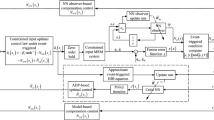Abstract
This paper proposes an approach to evaluate the performance of robot manipulator from the view of energy analysis. Based on the dynamics analysis of the manipulator, the Energy Distribution Index (EDI) is defined to depict the energy increment contribution of its subsystem to the whole manipulator. EDI is applied to the evaluation of the buffering capability of the manipulator working under unpredictable and heavy external loads. A series of buffering indices, the Static Buffering Index (SBI), Kineto-Static Buffering Index (KBI), Dynamic Buffering Index (DBI), and Global Buffering Index (GBI) are proposed to evaluate the buffering capability under different conditions. In order to acquire higher calculation accuracy, the general stiffness mapping of manipulators considering the actuator stiffness, inertia of the manipulator, damping, as well as elasticity of linkages is developed. Three different robot manipulators are studied as evaluation cases, in which the buffering structures are mechanism with variable topology, linear springs, and the elasticity of linkages respectively. The case studies show that the indices based on energy analysis have the advantage of coordinate free and are effective for buffering capability evaluation.
Similar content being viewed by others
References
Yoshikawa T. Manipulability of robotic mechanisms. Int J Robot Res, 1985, 4(2): 3–9
Stoughton R, Kokkinis T. Some properties of a new kinematic structure for robot manipulators. In: Proc of the 13th ASME Design Auto Con, Boston, 1987. 73–79
Salisbury J K, Craig J J. Articulated hands: force control and kinematic issues. Int J Robot Res, 1982, 1(1): 4–17
Yoshikawa T. Dynamic manipulability of robot manipulators. Int J Robot Res, 1985, 2(1): 113–124
Chiacchio P, Chiaverini S. Reformulation of the dynamic manipulability ellipsoid for robotic manipulators. Proceedings of 1991 IEEE International Conference on Robotics and Automation, Sacramento CA, USA, 1991. 73–79
Chiacchio P. New dynamic manipulability ellipsoid for redundant manipulators. Robotica, 2000, 18(4): 381–387
Asada H. A geometrical representation of manipulator dynamics and its application to arm design. J Dyn Syst Meas Control-Trans ASME, 1983, 105(3): 131–135
Kurazume R, Hasegawa T. A new index of serial-link manipulator performance combining dynamic manipulability and manipulating force ellipsoid. IEEE Trans Robot, 2006, 2(5): 1022–1028
Kim J, Park C, Park F C. Performance analysis of parallel mechanism architectures for CNC machining application. J Manuf Sci Eng-Trans ASME, 2000, 122(4): 753–759
Chang W, Lin C, Lee J. Force transmissibility performance of parallel manipulators. J Robotic Syst, 2003, 20(11): 659–670
Li H, Liu S, Guo X. Performance analysis for 3-RR(RR)R parallel mechanism based on Hessian matrix, Proceedings of the 2nd IEEE/ASME International Conference on Mechatronic and Embedded Systems and Applications, Beijing, China, 2006. 1–4
Bhattacharyya S, Hatwal H, Ghosh A. On the optimum design of Stewart platform type parallel manipulators. Robotica, 1995, 13(2): 133–140
Ceccarelli M, Carbone G. A stiffness analysis for CaPaMan. Mech Mach Theory, 2002, 37(5): 427–439
Liu X J, Jin Z L, Gao F. Optimum design of 3-DOF spherical parallel manipulators with respect to the conditioning and stiffness indices. Mech Mach Theory, 2000, 35(9): 1257–1267
Kim J C, Moon Y M, Kota S. A building block approach to the conceptual synthesis of compliant mechanisms utilizing compliance and stiffness ellipsoids. J Mech Des, 2008, 130(2): 1–10
Merlet J P. Jacobian, manipulability, condition number, and accuracy of parallel robots. J Mech Des, 2006, 128(1): 199–205
Merlet J P. Computing the worst case accuracy of a PKM over a workspace or a trajectory. The 5th Chemnitz Parallel Kinematics Seminar, Chemnitz, Germany, 2006. 3–96
Wang J, Wu C, Liu X J. Performance evaluation of parallel manipulators: motion/force transmissibility and its index. Mech Mach Theory, 2010, 45(10): 1462–1476
Wang J, Liu X, Wu C. Optimal design of a new spatial 3-DOF parallel robot with respect to a frame-free index. Sci China Ser E-Tech Sci, 2009, 52(4): 986–999
Khatait J P, Mukherjee S, Seth B. Compliant design for flapping mechanism: a minimum torque approach. Mech Mach Theory, 2006, 41(1): 3–16
Tantanawat T, Kota S. Design of compliant mechanisms for minimizing input power in dynamic applications. J Mech Des, 2007, 129(10): 1064–1075
Zhao K, Wang H, Chen G L. Dynamics simulation of topology-varying mechanisms by replacing local modeling units. ASME IDETC/CIE2008, Brooklyn, New York, USA, 2008. 511–519
Gosselin C. Stiffness mapping for parallel manipulators. IEEE Trans Robot Auto, 1990, 6(3): 377–382
Kao I, Ngo C. Properties of grasp stiffness matrix and conservative control strategy. Int J Robot Res, 1999, 18(2): 159–167
Huang C, Hung W H, Kao I. New conservative stiffness mapping for the Stewart-Gough platform. Proceedings of the 2002 IEEE International Conference on Robotics & Automation, Washington, D C, 2002. 823–828
Author information
Authors and Affiliations
Corresponding author
Rights and permissions
About this article
Cite this article
Wang, H., Zhao, K., Chen, G. et al. Energy Distribution Index for robot manipulators and its application to buffering capability evaluation. Sci. China Technol. Sci. 54, 457–470 (2011). https://doi.org/10.1007/s11431-010-4210-2
Received:
Accepted:
Published:
Issue Date:
DOI: https://doi.org/10.1007/s11431-010-4210-2




